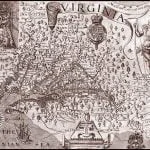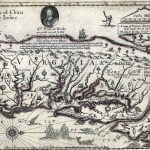
During the Third Powhatan War (1644-1646) warriors of the Rickohocken tribe, living near the headwaters of the James River, formed an alliance with Powhatan. They massacred all whites that they encountered as they marched down the James Valley. Over 500 white settlers were killed by the Native alliance. The Rickohockens probably would have destroyed the capital in Jamestown had not they run out of arrows. The colonists counter-attacked with firearms and steel weapons. The Rickohockens sued for peace.
In order to keep the Rickohockens from attacking the English colonists again, Royal Governor William Berkeley, began making trade contracts with them that included the purchase of Native American slaves and the sales of firearms. The Rickohockens initially raided Shawnee villages in what is now West Virginia to obtain slaves. Their territory steadily spread southwestward into northeastern Tennessee. French maps of the late 1600s and early 1700s document the movement of Muskogean and Yuchi villages southwestward along the Tennessee River in response to repeated Rickohocken attacks.
The Rickohockens’ location near the southern end of the Shenandoah Valley meant that tribes living in the Valley were highly vulnerable to these raids. Unfortunately, there are no corresponding British maps that document ethnic changes in western Virginia. What is documented, though, is that the Native population outside the Rickohocken domain began to drop starkly.
Around 1658, when Charles Stuart, the son of the decapitated King Charles I was still in exile, he granted a massive tract land to the Culpepper family in return for their financial and political assistance in regaining the throne of England. No one knew the exact size of the feudal grant because it had never been explored or mapped. Known as the Northern Neck it included all lands in Virginia north of the Powhatan Indian Reserve and the existing extent of European settlement. Of course, none of the Native American tribes living in the Northern Neck Proprietary Grant were aware that they were now feudal tenants of the Culpepper family. There would soon be means to clear them out of the way.

Upon Charles II ascension to the throne, William Berkeley, a royalist, was renamed Virginia’s governor in 1660. Berkeley stacked the House of Burgesses with royalists and planters. He then pushed through laws that for the first time institutionalized human slavery. Prior to that time, Native American and African laborers on plantations were considered bond servants with limited civil rights. Now, they were private property, whose children were born slaves and could be sold like livestock.
The Colony of Virginia soon signed a contract with the Rickohockens. The Rickohockens were given firearms and fixed prices for Native American slaves delivered to planters on the coast. A coalition of planter agreed to buy all Native American slaves that the Rickohockens could deliver.
The tactics that the Rickohockens used to obtain slaves were catastrophic to other native peoples, who were almost defenseless against the surprise raids, utilizing firearms. The Rickohockens would kill all adult males and babies they encountered. The elderly and mature adult females were sometimes spared, sometimes killed. The older children, youth and young females were tied together with ropes and poles then marched to coastal slave stockades.
There is evidence that the first place that the Rickohocken raiders went was the densely populated Shenandoah Valley. A History of Shenandoah County, VA by John Walter Wayland mentions that the British explorers, who entered the valley in the late 1600s encountered remnants of a tribe they called the Shanantoa, Senantoa, or Cenuntoa. They observed mounds and the ruins of villages throughout the valley. In the early 1700s, a few survivors of the valley’s pre-European inhabitants, now living in Pennsylvania, stated that “Indians from the south” had raided their towns and villages, killing or enslaving most of the population.
Twentieth century historians interpreted the label “Indians from the south” to possibly mean the Catawba of South Carolina. The Catawba were also victims of Rickohocken slave raids in the late 1600s. Catawba warriors did not chase Iroquois and Delaware raiding parties through the Shenandoah Valley until after 1715, when the Tuscarora War ended. The Catawba-Iroquois/Delaware War erupted because the Catawba had aided the British settlers in their war against the Iroquoian Tuscarora.
Settlers on the Potomac River in Loudon County in the 1730s reported that a Delaware war party returning from South Carolina, “sacrificed” a young Catawba woman upon reaching the Potomac then crossing into their home territory. One member of the party returned the next day to cut off her soles, so her spirit could not haunt them.

Further evidence that Native American slave raiders were deliberately used to depopulate the Northern Neck Estate of the Culpepper Family comes from an article in the history of Loudon County, VA by Ruth Bentley of the Waterford Foundation. Loudon is a suburb of Washington, DC. Early settlers of Jamestown, such as John Smith, made contact with an alliance of Siouan villages in northern Virginia called the Manahoac during the early 1600s. The Manahoac villages were located east of the Shenandoah Valley in the Blue Ridge Mountains and upper Piedmont.
By 1669 a colonial census counted only 50 Manahoac men of military age, due to catastrophic attacks by Indian slave raiders. Soon thereafter, the surviving Manahoac moved farther south to join other Siouans in the vicinity of present day Charlottesville. It is documented that they were repeatedly attacked by Rickohockens while living in the Charlottesville area. The Siouan alliance eventually moved southwestward to near Lynchburg, then south again to near the Virginia-North Carolina Line, before disappearing from history around 1753 when they moved to New York and joined the Iroquois Confederacy.
Most Virginia historians blame the Iroquois for the depredations on the Manahoac. This is a dubious speculation. At the exact same time that Manahoac were decimated, the Rickohockens were heavily involved with the Native American slave trade. Why would the Manahoac eventually travel far to the north to join the Iroquois Confederacy, if they had been almost destroyed by the Iroquois?
Historian Samuel Kercheval, who wrote A History of the Valley of Virginia in the 1830s, studied the evidence of when Shanandoa Indians were almost exterminated. Without even knowing of the Rickohocken Indians existence, he estimated that the holocaust occurred between the time of King Charles II’s restoration (1660) and Bacon’s Rebellion (1676.) That is exactly when the Rickohockens were most active in the Native American slave trade.
